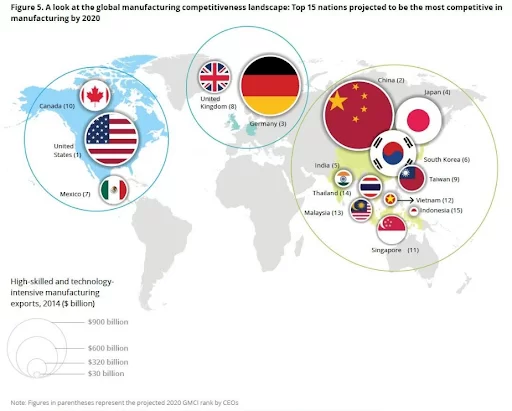Is there a way to stop progress? If you are a die-hard fan of modern innovations and keep up with recent technological trends, this question is rhetorical. According to Gartner, last year, the volume of the IT industry as a whole has amounted to approximately $3.65 trillion – an annualized increase of 3.9%. What’s more, this number is predicted to reach $3.77 trillion in 2019. Thus, by the end of this year, the market may show a 3.2 percent growth.
These figures look quite impressive, and the industry’s growth is steady. However, only time will tell if those forecasts will become reality as whose expectations may be impaired by the recently intensified trade war between the United States and China. There are strong suspicions that the consequences of this geopolitical tension could seriously impact the balance of the global IT market.

One way or another, let’s check the top domains within the manufacturing sector and the respective numbers they generate.
Internet of Things
The ever growing interest of businesses towards the Internet of Things (aka IoT) has a positive effect on the industry’s development. According to the estimates by IDC, the IoT market will show steady growth and its volume will reach $1.2 trillion by 2022. It is predicted that by 2025, 38.6 billion devices will be connected to the Internet, and in 2030 this figure will exceed the milestone mark of 50 billion. For comparison: in 2018, the number of IoT devices was estimated at approximately 22 billion (data from Strategy Analytics, currently known as Techinsights).
If we consider the individual segments of the IoT industry, the highest growth rates will be shown by the consumer sector, insurance, and healthcare domains. At the same time, the manufacturing domain will remain the leader in terms of investments due to a large number of installed devices and high demand for solutions for vehicle management, vehicle monitoring, and asset management. According to IDC forecasts, the expenses in each of these IoT segments will exceed $150 billion in 2022.
The emergence of new IoT modules which support the fifth generation of the mobile connectivity will begin to storm plants and factories. It is estimated that precisely the emergence of 5G will contribute to the further development of the industry in 2019 as 5G networks offer faster speed and more reliable connections on smartphones and other devices.

The development of the Internet of Things will entail an increase in the cost of ensuring the security of IoT devices. Gartner’s research shows that throughout 2016-2018, almost 20% of the organizations around the world faced at least one cyber threat related to the Internet of Things.
The experts believe that in the foreseeable future, the number of attacks on IoT devices will only grow. If a year ago the costs associated with the protection of the infrastructure were estimated at about $1.51 billion, in the current year, the costs will increase up to $1.93 billion, exceeding three billion US dollars in 2021.
It is noted that the main problem of the Internet of Things is outdated device firmware. At best, updates come out with significant delays, at worst, they are not released at all. For what is worth, sometimes the possibility of an update is not even technically foreseen.
As a result, many IoT devices are cracked using trivial methods, such as vulnerabilities in the web interface. Almost all such vulnerabilities are critical and are actively used by hackers. By 2030, IoT will add up to $15 trillion to the growth of global GDP, according to analysts of General Electric. Ah, those predictions!
Big Data Analytics
Big data analytics (or simply BDA) is becoming one of the most popular features of the way the modern business operates. According to IDC, the volume of the BDA market will reach $260 billion by 2022. But this is three years from now, what about today? As its manufacturing siblings, the market is on the rise: the year 2018 saw substantial annual growth of 12%. The largest segments of the big data industry are:
- IT services generating $77.5 billion of revenue;
- software development services which contributed another $67.2 billion;
- hardware solutions with $23.7 billion;
- business services adding $20.7 billion.
BDA is totally beneficial for the industry. Within a plant, it provides a detailed picture of what has happened, what is happening now, and what will happen the next day or in a year. In subsequent years, further increases in costs are expected in the big data and business intelligence market. Thus, the CAGR indicator in the period from 2018 to 2022, according to IDC experts, will be 13.2%. From a geographical point of view, the United States will remain the largest region in terms of BDA costs.
Artificial Intelligence
Within the domain of manufacturing, artificial intelligence enables collaborative robotics and automated workflows based on predictive analytics. Secondly, the technology improves recruitment and retention of industry professionals and optimizes the use of the equipment and overall plant effectiveness. Numerous potential use cases for AI in manufacturing make the industry one of the most attractive sectors for global venture capital. Technologies that derive from AI (aka cognitive technologies) include:
- machine learning;
- computer vision;
- natural language processing;
- speech recognition;
- robotics;
- optimization;
- rules-based systems;
- and planning and scheduling.
Another trend is the rapid development of services using machine learning technologies and artificial intelligence systems based on neural networks. Machine learning refers to the ability of computer systems to improve their performance by exposure to data, without the need to follow explicitly programmed instructions.

According to the International Data Corporation, in 2018, the cost of AI systems globally was valued approximately $ 24.9 billion. This year, as expected, the industry will grow almost one and a half times – by 44%. As a result, the global market volume will reach $35.8 billion. In the period up to 2022, the CAGR indicator is projected at 38%. Thus, in 2022 the industry volume will reach $79.2 billion, and this is twice as much compared to the current year.
“The numbers show that right now when our ability to interact with others and empathy set us apart from our future automated colleagues, we allow our muscles of sympathy to atrophy,” writes Belinda Parmar, author of the book “Empathy Business” and a WEF expert.
The future, in her opinion, is for those who will be able to preserve their humanity and at the same time learn how to effectively interact with AI in any domain, not just manufacturing. At the same time, manufacturers desperately need a big number of human workers.
The recent study from Deloitte and The Manufacturing Institute claims that skilled production, digital talent, and operational management positions will be three times hard to fill in the next three years with 2.4 million positions being unfilled between 2018 and 2028. In the perspective of ten years, North America seems to be the place of the most dynamic growth since this region is the world center of innovative technologies, while Germany seems to be the industry’s leader in Europe.
Information Security
Significant contributions to the development of the global IT market are made by companies offering solutions for cybersecurity from digital threats. As a result, the volume of the information security market will reach approximately $133.8 billion by 2022.

Those numbers are quite understandable considering the fact that security and personal data loss represent the most significant issue in the entire IoT ecosystem. Forbes claims that 60% of consumers are worried about the vulnerabilities of connected devices, and 62% among them consider confidentiality the biggest problem. Moreover, 92% of IoT developers think that security will be a problem to tackle in the future.
As a matter of fact, the question of security is omnipresent, no matter if we talk about the transfer of enterprise data, the exchange of personal data or the integrity of the IoT system.
The problem of ensuring confidentiality in the scale of connected houses and related cities also needs to be addressed. In 2018, the biggest challenge is still the security of Big Data in IoT ecosystems. Sure enough, the application of this data can change the situation and help in solving global environmental, political, economic and medical problems. But on the other hand, data manipulation may put into jeopardy the security of industries, economies, and even countries.
To Sum Up
Apart from the technological aspect, these innovations represent a captivating trend in the world economy. Nowadays, the competitive advantage in manufacturing no longer belongs solely to the cost-competitive countries like the UK or the US. We can clearly see that those nations that have robust innovation ecosystems are beginning to take their share off the market.
For instance, The Global Manufacturing Competitiveness Index (GMCI) study claims that countries investing in emerging manufacturing technologies and innovations will become more competitive than those choosing to beat the competition on price alone.

One more thing: the trends mentioned above are especially attractive for small and medium-sized manufacturers as solutions which increase productivity and profitability have never been more accessible. Is your company ready to seize the opportunity? The article contains a lot of predictions, but the future begins at any given moment. Check out our manufacturing solutions and drop us a line at [email protected]









